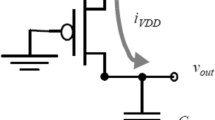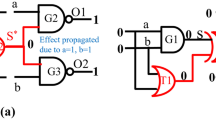Abstract
In today’s semiconductor industry, the increasing growth of sub-micron technology has resulted in the difficulty of VLSI testing. The biology is a rich source of inspiration for designers to solve the problems related to VLSI testing such as high fault coverage, less test time, efficient test pattern generation and to reduce the power consumption during testing. The main goal of this paper is to analyze the bio-inspired test pattern generation mechanisms such as Genetic algorithms and cellular automata for the built in self test. Here we have introduced the concept of cellular automata, and analyzed the parameters (like area and power) obtained from the simulation results of cellular automata and LFSR (type I, II). The experiments are performed for the Genetic algorithm, Random and deterministic cellular automata Test Pattern generation for combinational ISCAS 85 and sequential ISCAS 89 benchmark circuits. Experimental results show that more fault coverage is achieved with less Test Vectors with adequate time.
Access this chapter
Tax calculation will be finalised at checkout
Purchases are for personal use only
Preview
Unable to display preview. Download preview PDF.
Similar content being viewed by others
References
Palash Sarkar. 2000. A brief history of cellular automata. ACM Comput. Surv. 32, 1 (March 2000), 80-107. DOI=10.1145/349194.349202 http://doi.acm.org/10.1145/349194.349202.
Yu Yuecheng, Wang Jiandong, Ding jianli “An Extended Model of the Cellular Automata” Computing, Communication, Control, and Management, CCCM 2009. ISECS International Colloquium, 2009. Vol. 1 Pp 66 – 69.
Fulvio Corno, Maurizio Rebaudengo, Matteo Sonza Reorda, Giovanni Squillero, and Massimo Violante. 2000. Low Power BIST via Non-Linear Hybrid Cellular Automata. In Proceedings of the 18th IEEE VLSI Test Symposium (VTS ‘00). IEEE Computer Society, Washington, DC, USA, 29-.
Ding Jianli, Yu Yuecheng, Wang Jiandong “A Model for Predicting Flight Delay and Delay Propagation Based on Parallel Cellular Automata” Computing, Communication, Control, and Management, CCCM 2009. ISECS International Colloquium 2009.
Zhang Chuanwu “Performance Analysis of the CPLD/FPGA Implementation of Cellular Automata” Embedded Software and Systems Symposia,. ICESS Symposia ‘08. International Conference 2008.
Bei Cao, Liyi Xiao, Yongsheng Wang “A Low Power Deterministic Test Pattern Generator for BIST Based on Cellular Automata” IEEE International Symposium on Electronic design, test and applications, 2008. 266 – 269.
Sukanta Das, Debdas Dey, Subhayan Sen, Biplab K Sikdar, and P Pal Chaudhuri. 2004. An efficient design of non-linear CA based PRPG for VLSI circuit testing. In Proceedings of the 2004 Asia and South Pacific Design Automation Conference (ASP-DAC ‘04). IEEE Press, Piscataway, NJ, USA, 110-112.
Nakada, K., Asai, T., Hirose, T., & Amemiya, Y. (2004). Digital VLSI implementation of ultra-discrete cellular automata for simulating traffic flow. Electrical Engineering, 1(1), 394-397.
Biplab K. Sikdar, Debesh K. Das, Vamsi Boppana, Cliff Yang, Sobhan Mukherjee, and P. Pal Chaudhuri. 2001. Cellular automata as a built in self test structure. In Proceedings of the 2001 Asia and South Pacific Design Automation Conference (ASP-DAC ‘01). ACM, New York, NY, USA, 319-324. DOI=10.1145/370155.370367 http://doi.acm.org/10.1145/370155.370367.
Krishna Kumar S., Uday Bhaskar P., and Santanu Chattopadhyay. 2009. Low Power Pseudoexhaustive Testing with Cellular Automata. In Proceedings of the 2009 International Conference on Advances in Computing, Control, and Telecommunication Technologies (ACT ‘09). IEEE Computer Society, Washington, DC, USA, 419-423. DOI=10.1109/ACT.2009.109 http://dx.doi.org/10.1109/ACT.2009.109.
M.L. Bushnell, V.D. Agrawal, Essentials of Electronics Testing for Digital, Memory & Mixed Signal VLSI Circuits, Kluwer Academic Publishers, Boston MA, 2000.
P.H. Bardell, W.H. McAnney, J. Savir, Built-in test for VLSI: Pseudorandom Techniques, John Wiley and Sons, New York, 1987.
C. Stroud, A Designer’s Guide to Built-In Self-Test, Kluwer Academic Publishers, Bos-ton MA, 2002.
S. Zhang, R. Byrne, J.C. Muzio, D.M. Miller, “Why cellular automata are better than LFSRs as built-in self-test generators for sequential-type faults”, IEEE International Symposium on Circuits and Systems ISCAS 1994: 69-72, Vol. 1, 1994.
Xiaodeng Zhang,Roy, K. Peak power reduction in low power BIST. Proceedings. IEEE 2000 First International Symposium on Quality Electronic Design, 2000. ISQED 2000425 – 432.
Sikdar, B. K., Ganguly, N., & Chaudhuri, P. P. (2005). Fault diagnosis of VLSI circuits with cellular automata based pattern classifier. IEEE Transactions on Computer-Aided Design of Integrated Circuits and Systems VOL. 24, NO. 7, JULY 2005 pp 1115-1131.
Turbo tester Manual, “Turbo Tester Reference Manual”, Version 02.10, Tallinn Technical University, Estonia, 2002 http://www.pld.ttu.ee/TT.
M.Aarna, E.Ivask, A.Jutman, E.Orasson, J.Raik, R.Ubar, V.Vislogubov, H.D.Wuttke. Turbo Tester - Diagnostic Package for Research and Training. East-West Design & Test Conference - EWDTC’03, Scientific-Technical Journal Radioelectronics and Informatics, No. 3 (24), pp. 69-73, July-Sept. 2000.
S. Boubezari, B. Kaminska, “A Deterministic Built-In Self-Test Generator Based on Cellular Automata Structures,” IEEE Trans. Computers, V.44, N.6, Jun. 1995, pp. 805-816.
P.D. Hortensius, R.D. McLeod, W. Pries, D.M. Miller, H.C. Card, “Cellular Automata-Based Pseudorandom Number Generators for Built-In Self-Test,” IEEE Transaction on Computer- Aided Design, V.8, N.8, Aug. 1989, pp. 842-859.
K.Paramasivam, “Reordering Algorithm for Minimization of Test power in VLSI Circuits”, Engineering Letters, Issues_v14 pp 78-83, 2007.
Author information
Authors and Affiliations
Corresponding author
Editor information
Editors and Affiliations
Rights and permissions
Copyright information
© 2013 Springer India
About this paper
Cite this paper
Singh, B., Narang, S.B., Khosla, A. (2013). Analysis of Cellular Automata and Genetic Algorithm based Test Pattern Generators for Built In Self Test. In: Bansal, J., Singh, P., Deep, K., Pant, M., Nagar, A. (eds) Proceedings of Seventh International Conference on Bio-Inspired Computing: Theories and Applications (BIC-TA 2012). Advances in Intelligent Systems and Computing, vol 201. Springer, India. https://doi.org/10.1007/978-81-322-1038-2_36
Download citation
DOI: https://doi.org/10.1007/978-81-322-1038-2_36
Published:
Publisher Name: Springer, India
Print ISBN: 978-81-322-1037-5
Online ISBN: 978-81-322-1038-2
eBook Packages: EngineeringEngineering (R0)




